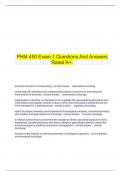Exam (elaborations)
PHM 450 Exam 1 Questions And Answers Rated A+.
PHM 450 Exam 1 Questions And Answers Rated A+.
primarily .involved .in .toxicity .testing .- .correct .answer. . . . .descriptive .toxicology
concerned .with .identifying .and .understanding .cellular, .biochemical, .and .molecular .mechanisms .of .toxicants .- .correct .answer. ....
[Show more]
Preview 4 out of 34 pages
Uploaded on
August 23, 2024
Number of pages
34
Written in
2024/2025
Type
Exam (elaborations)
Contains
Questions & answers
phm 450 exam 1 questions and answers rated a
concerned with identifying and understanding cellu
responsible for deciding on the basis of the avai
Institution
PHM 450
Course
PHM 450
$12.49
100% satisfaction guarantee
Immediately available after payment
Both online and in PDF
No strings attached
PHM 450 Exam 1 Questions And Answers




